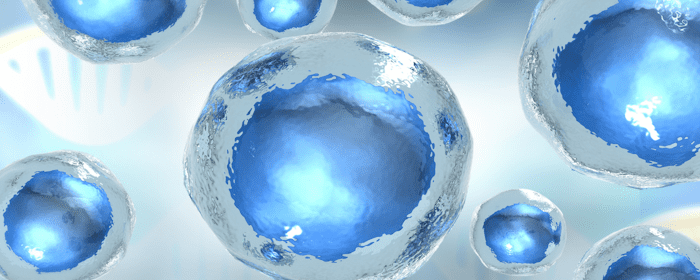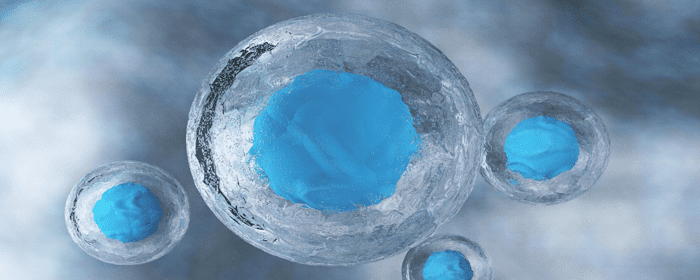
by admin | Dec 27, 2024 | Mesenchymal Stem Cells, Osteoarthritis, Regenerative Medicine, Stem Cell Research, Stem Cell Therapy
Primarily a result of its avascular structure and the relatively low metabolic activities of chondrocytes, cartilage has demonstrated a very limited ability to self-repair.
Currently, the primary interventions for cartilage-related injuries only postpone further cartilage deterioration and fail to fully restore or repair cartilage. The limited success of current clinical treatment options for cartilage-related injuries has led to the development of several regenerative medical therapies, including using mesenchymal stem cells (MSCs) as a new strategy in the treatment of cartilage injuries.
Specifically, MSCs have been found to be isolated from mesenchymal tissue and be differentiated into chondrocytes with the support of chondrogenic factors or scaffolds to repair damaged cartilage tissue.
As part of this review, Le et al. highlight the successful repair of cartilage using MSCs or MSCs in combination with chondrogenic factors and/or scaffolds. The authors also provide a detailed presentation of the outcomes of different MSC-based strategies for cartilage regeneration and discuss their prospective translation to use in clinical practice.
Additionally, the authors discuss a number of specific MSC or MSC-combination factors that have shown potential for positive cartilage regeneration outcomes.
The use of MSC alone demonstrated the potential to possibly delay future cartilage degeneration and has been successful in relieving pain and improving joint function in patients with OA and RA. While the implantation of MSCs alone failed to regenerate the injured cartilage, it did prevent chondrocyte apoptosis.
The authors also pointed out that the application of chondrogenic factors could regulate the differentiation, proliferation, and metabolic activity of MSC and have been shown to increase the therapeutic efficacies of MSCs.
The 3D environment provided through scaffolding has a crucial role in maintaining the chondrocyte phenotype of MSCs, primarily by enabling the homogeneous distribution of MSCs and providing appropriate substrate for cell growth and mechanical integrity for post-surgical implantation. According to Le et al. using this approach could induce the regeneration required for complete and functional cartilage tissue.
While there is still much to be investigated in the area of using MSC-based therapies to create bionic tissues, the authors conclude that the integration of these therapies into current clinical approaches will overcome the current existing challenges and result in a biomimetic cartilage regenerative therapy. Source: Le H, Xu W, Zhuang X, Chang F, Wang Y, Ding J. Mesenchymal stem cells for cartilage regeneration. J Tissue Eng. 2020;11:2041731420943839. Published 2020 Aug 26. doi:10.1177/2041731420943839

by admin | Dec 20, 2024 | Mesenchymal Stem Cells, Neurodegenerative Diseases, Regenerative Medicine, Stem Cell Research, Stem Cell Therapy
According to a recent study released by The Lancet Neurology, more than 3 billion people worldwide are living with a neurological condition, making it the leading cause of ill health and disability worldwide.
The rate of neurological conditions, including neurodevelopmental disorders (such as autism), neurodegenerative disorders (such as Alzheimer’s), movement disorders (such as Parkinson’s), brain injuries, neuroinfections, and multiple sclerosis, has increased by 18% since 1990 and now affects 1 out of every 3 people on the planet.
Currently, limited or no treatment options exist for these conditions. Cell-based therapies, and particularly those involving mesenchymal stem cells (MSCs) have been intensively studied as potential treatment options for neurological diseases.
As part of this review, Soares et al. share current knowledge of MSC-based therapies for neurological diseases and discuss the challenges associated with generating more efficient cell therapy products for these conditions.
According to the authors, the therapeutic potential of MSCs is attributed to their homing property, multilineage differentiation, and paracrine function. Specifically, MSCs are able to migrate toward injured tissues, engraft, and differentiate into functional cells. MSCs have also demonstrated the ability to repair, not replace, damaged cells and tissues.
MSCs contribute to the repair of cells and tissues through the paracrine action which demonstrates a wide range of immunomodulatory, angiogenic, antiapoptotic, and growth factors.
Soares et al. include a discussion of the most recent research regarding the safety, efficacy, and mechanism of action of MSC-based therapy in a number of neurological diseases, including amyotrophic lateral sclerosis, glaucoma, stroke, spinal cord injury, and autism. According to the authors, while most of the preclinical studies were conducted using animal models, both preclinical and clinical findings have demonstrated positive effects on safety, tolerability, and functional improvement after transplantation of MSCs
Considering the promising potential and identified limitations of using MSC-based therapies for the treatment of neurological disorders, Soares et al. conclude this review by calling for further study with the aim of developing better strategies to obtain larger quantities of healthy cells for use in cell therapies and to reduce the variability of results due to the biological characteristics of MSCs.
Source: Soares MBP, Gonçalves RGJ, Vasques JF, et al. Current Status of Mesenchymal Stem/Stromal Cells for Treatment of Neurological Diseases. Front Mol Neurosci. 2022;15:883378. Published 2022 Jun 16. doi:10.3389/fnmol.2022.883378

by admin | Dec 6, 2024 | Mesenchymal Stem Cells, Regenerative Medicine, Stem Cell Research, Stem Cell Therapy
In recent years, mesenchymal stromal/stem cells (MSCs) and their exosomes have attracted interest as potential treatments for degenerative diseases. MSCs have unique characteristics such as the ability to renew themselves, differentiate into different cell types, and modulate the immune system. These properties make them valuable in medical research, and both laboratory and clinical studies have shown promising results.
However, there are challenges with using MSCs directly, especially when it comes to allogeneic transplantation, where cells are taken from a donor rather than the patient’s own body. These issues include risks of immune rejection and limited differentiation capabilities. To address these limitations, scientists have proposed using exosomes derived from MSCs, which are tiny particles that can carry therapeutic molecules directly to target cells.
Understanding Intervertebral Disc Disease (IDD)
One of the degenerative conditions where MSCs and their exosomes are being studied is intervertebral disc disease (IDD). The intervertebral disc (IVD) is a complex structure located between the vertebrae in the spine. It consists of three main parts: the inner nucleus pulposus (NP), the outer annulus fibrosus (AF), and the cartilage endplates (CEP). These components work together to allow the spine to move and to absorb mechanical stress. The NP is soft and gelatinous, helping to absorb shock, while the AF is made up of tough, fibrous tissue that surrounds and protects the NP. The CEP, which is less than 1 mm thick, serves as a channel for nutrient transport.
IDD occurs when excessive mechanical stress, genetic factors, or environmental influences lead to the degeneration of these disc components. This results in the loss of cells and tissue integrity within the disc, causing symptoms like chronic low back pain, which is a common issue affecting people as they age. Low back pain due to IDD can significantly impact quality of life, making it a widespread public health concern. Current treatments mainly focus on alleviating pain rather than addressing the root cause, and options like surgery can come with significant risks and side effects.
Role of MSCs in Regenerative Therapy for IDD
MSCs are multipotent cells found in various tissues throughout the body. They can differentiate into many cell types, including those involved in bone, cartilage, and fat tissue formation. This versatility makes them useful in regenerative medicine, especially for conditions like IDD. In treatment, MSCs can be injected into the damaged area, where they help promote healing by transforming into disc-related cells and encouraging the growth of native cells within the IVD. MSCs can also help reduce cell death (apoptosis), increase the production of new cells, and prevent further degeneration.
Using Exosomes as an Alternative to MSCs
Researchers have turned their attention to exosomes, which are small vesicles naturally released from cells. Exosomes are particularly promising because they can carry various therapeutic molecules, such as proteins, lipids, and RNA, directly to target cells. Unlike whole-cell therapies, exosome treatments do not carry the same risks, such as immune rejection or the potential for cells to transform into tumors. Exosomes can also act as delivery vehicles for drugs, thanks to their small size, natural biocompatibility, and ability to travel to damaged tissues.
In the context of IDD, exosomes derived from MSCs can help reduce inflammation, encourage the repair of damaged cells, and improve the overall health of the intervertebral disc. This approach allows for a cell-free treatment that retains many of the benefits of MSC therapy.
Causes and Cellular Changes Associated with IDD
As part of this review, the authors highlight several factors that contribute to the development and progression of IDD. These include aging, genetics, environmental influences, and lifestyle choices. For example, lack of physical activity, smoking, or frequent exposure to vibration can all accelerate disc degeneration. Some people may also have genetic predispositions that make their spinal discs more prone to breakdown. At the cellular level, IDD involves the gradual loss of key cell types, including nucleus pulposus cells (NPCs), which are essential for maintaining the disc’s structure and function. As these cells decrease in number, the disc loses its ability to absorb mechanical stress, leading to further tissue deterioration.
Traditional and Emerging Treatments for IDD
Treatment options for IDD vary based on the severity of the condition. For mild cases, rest, physical therapy, and medications like anti-inflammatory drugs and muscle relaxants are often used to relieve pain. However, these approaches do not stop the underlying degeneration, and pain can become chronic for some patients. In severe cases, surgical interventions, such as spinal fusion, may be necessary, but these procedures come with risks, such as recurrent disc problems and long recovery times.
Regenerative therapies, which aim to repair and restore damaged tissues, have gained attention as a potential solution for IDD. MSCs have emerged as a leading option for regenerative treatment because of their ability to promote cell growth and tissue healing. By injecting MSCs into the affected area, it is possible to enhance the disc’s cellular environment, reduce inflammation, and stimulate the production of new extracellular matrix components.
Potential Benefits of MSC-Derived Exosomes
Using MSC-derived exosomes for IDD treatment offers several advantages over traditional cell therapy. Exosomes are nanosized, making them more effective in delivering therapeutic agents to specific areas of damage. They also carry a variety of molecules that can influence cellular behavior and promote healing. For instance, exosomes can reduce inflammation, encourage the growth of healthy cells, and prevent cell death in the damaged disc. Additionally, their natural compatibility with the body and low risk of triggering immune responses make them a safer option for patients.
Exosome therapy is still in the experimental stages, but early studies have shown promising results in treating various degenerative diseases, including IDD. As researchers continue to explore the therapeutic potential of these tiny vesicles, there is hope that they could provide a viable, less invasive alternative to existing treatments.
New Approaches to Treating Intervertebral Disc Degeneration
The rise in spine-related problems due to modern lifestyles has led to increased interest in finding better treatments for conditions like IDD. While current therapies primarily focus on pain management, regenerative approaches that aim to repair damaged tissues offer a more comprehensive solution. MSCs have shown promise in treating IDD, but their limitations have driven scientists to explore the use of exosomes.
Widjaja et al. conclude that as research progresses, exosome-based therapies could become a safer, more effective option for patients with degenerative disc diseases, potentially improving quality of life for millions.
Source: Widjaja G, Jalil AT, Budi HS, Abdelbasset WK, Efendi S, Suksatan W, Rita RS, Satria AP, Aravindhan S, Saleh MM, Shalaby MN, Yumashev AV. Mesenchymal stromal/stem cells and their exosomes application in the treatment of intervertebral disc disease: A promising frontier. Int Immunopharmacol. 2022 Apr;105:108537. doi: 10.1016/j.intimp.2022.108537. Epub 2022 Jan 29. PMID: 35101851.

by admin | Nov 29, 2024 | Mesenchymal Stem Cells, Multiple Sclerosis, Neural Stem Cells, Regenerative Medicine, Stem Cell Research, Stem Cell Therapy
Multiple sclerosis (MS) is an autoimmune disease of the central nervous system (CNS) that can take different forms: relapsing-remitting (RRMS), secondary progressive (SPMS), and primary progressive (PPMS). In RRMS, symptoms flare up and then ease, largely due to inflammation, and there are many therapies to manage these relapses. In SPMS and PPMS, the disease gradually progresses without relapses, leading to accumulating disability. Treatments for these progressive forms are limited, and the therapies available are generally less effective than for RRMS.
In this study, Harris et al. explores the use of stem cell-based treatment, specifically mesenchymal stem cell-derived neural progenitors (MSC-NPs), for people with progressive MS.
MSC-NPs are cells derived from a patient’s own bone marrow and have potential regenerative and immune-modulating effects. Early research suggests that MSC-NPs can provide beneficial effects in animal models of MS.
This clinical trial was initiated to test the safety and early efficacy of MSC-NPs when injected directly into the spinal fluid of patients with progressive MS. Specifically, Harris et al. wanted to see if these patients would experience fewer or slower disease-related declines after receiving repeated injections of MSC-NPs.
Evaluating Safety and Early Efficacy Trends
According to the authors, this study found that repeated injections of MSC-NPs were generally safe. Over the two-year follow-up period, no serious side effects were reported by any of the patients. A minor headache was reported by one patient, which did not require treatment, and some other minor issues were reported but were deemed unrelated to the study treatment.
This confirms the long-term safety of MSC-NPs, which is critical as cell therapies become more widely tested for neurological diseases like MS.
While Harris et al.’s study was not designed to determine whether MSC-NPs were definitively effective, some additional trends were observed:
- Patients with lower levels of disability at the start of the study tended to show more improvement in their mobility and overall functioning than those with higher disability scores.
- Most patients who benefited were those who could still walk when they started the trial, suggesting MSC-NP therapy might be more effective in people with less advanced disability.
- Of the three patients with primary progressive MS, two showed stable disability scores over the two years following treatment. However, the sample size was too small to draw firm conclusions on its effects in PPMS compared to SPMS.
While these findings are promising, the study has significant limitations. With only 20 patients, the study was too small to determine definitive efficacy, so a larger, placebo-controlled trial is necessary to confirm any potential benefits of MSC-NPs.
Additionally, the open-label design, where both patients and researchers knew who was receiving the treatment, could mean that some effects may have resulted from a placebo response rather than the treatment itself. Furthermore, the therapy may be more effective for patients with lower disability scores, but more research is required to identify which patients are the most suitable candidates for MSC-NP treatment.
Future Directions for MSC-NP Therapy in Progressive MS
Harris et al.’s study has laid the groundwork for further research by establishing MSC-NPs as a safe treatment option over a two-year period. Based on these findings, a larger Phase II trial is underway, involving 50 patients who will receive MSC-NP injections or a placebo over an extended period. This trial will be double-blinded (neither patients nor researchers will know who is receiving the treatment) to give more definitive answers about MSC-NP’s effects on progressive MS.
In summary, MSC-NPs appear to be a safe treatment option for people with progressive MS, with some early evidence suggesting potential benefits in reducing disability for those with less advanced disease. These findings contribute to the understanding of cell-based therapies in MS and support further exploration of MSC-NPs in larger, controlled studies. While MSC-NPs offer hope for future therapies, the authors call for more rigorous research to clarify their impact on long-term disease progression and patient quality of life.
Source: Harris VK, Stark JW, Yang S, Zanker S, Tuddenham J, Sadiq SA. Mesenchymal stem cell-derived neural progenitors in progressive MS: Two-year follow-up of a phase I study. Neurol Neuroimmunol Neuroinflamm. 2020 Dec 4;8(1):e928. doi: 10.1212/NXI.0000000000000928. PMID: 33277427; PMCID: PMC7738177.

by admin | Nov 22, 2024 | Mesenchymal Stem Cells, Regenerative Medicine, Stem Cell Research, Stem Cell Therapy
Since their discovery in 1960, mesenchymal stem cells (MSCs) have been extensively studied for their potential to treat a wide range of diseases, including autoimmune diseases, bone/cartilage repairs, diabetes, cardiovascular diseases, and neurological and immune-related disorders.
MSCs have demonstrated the ability to improve these conditions through their ability to repair injured or affected tissue by migrating to the injured site, engrafting, and differentiating to end-stage functional cells. Additionally, MSCs have shown the ability to modulate immune cell types, promote neovascularization, increase angiogenesis, enhance cell viability, and inhibit cell death.
While the results of several animal studies exploring the therapeutic benefits of MSCs have been promising, the lack of therapeutic results demonstrated from some clinical trials has created the need to further explore and understand the specific role of MSCs as a viable treatment option.
In this review, Fan et al. summarize the mechanisms underlying the protective effects of MSCs and provide an overview of recent developments in MSC-based therapy.
The authors attribute the therapeutic potential of MSCs to two primary aspects, replacement of the damaged tissue through differentiation and regulation of immune responses by immunomodulatory function. These aspects are specifically attributed to the paracrine function, which secretes a variety of factors to exert immunomodulatory, angiogenic, antiapoptotic, and antioxidative effects.
Fan et al. point out that although MS-based therapies have made significant progress, clinical trials and publications demonstrating mixed and contradictory results have prevented the advancement of MSCs into daily clinical application. The authors conclude that these disparities are most likely due to the large variability in key factors such as cell source, dosage, administration route, and administration timing.
Considering these disparities, Fan et al. call for the standardization of procedures of MSC isolation and expansion as crucial to improving the safety, efficacy, and outcomes of future clinical investigations of MSC-based therapies.
Source: Fan XL, Zhang Y, Li X, Fu QL. Mechanisms underlying the protective effects of mesenchymal stem cell-based therapy. Cell Mol Life Sci. 2020;77(14):2771-2794. doi:10.1007/s00018-020-03454-6

by admin | Nov 15, 2024 | Mesenchymal Stem Cells, Regenerative Medicine, Stem Cell Research, Stem Cell Therapy, Uncategorized
Mesenchymal stem cell (MSC) therapy has gained attention as a potential treatment for decompensated liver cirrhosis (DLC), a severe form of liver disease that occurs when the liver can no longer function properly. Liver cirrhosis, especially when caused by chronic hepatitis B (HBV), leads to a significant decline in health, and current treatments do not always yield long-term benefits.
MSCs, particularly those derived from bone marrow (BM-MSC) and umbilical cord (UC-MSC), have shown promise in improving liver function in both animal and human studies. However, the long-term safety and efficacy of MSC therapy, especially in human patients with liver diseases like DLC, remain uncertain. Shi et al.’s study sought to address this gap by observing the effects of UC-MSC therapy in patients with decompensated liver cirrhosis over a follow-up period of 75 months.
Introduction
In recent years, MSC therapy has emerged as a novel approach for treating liver disease, particularly cirrhosis. Research on animal models has demonstrated that bone marrow-derived MSCs (BM-MSCs) can reduce liver fibrosis and even reverse acute liver failure. These findings have also extended to clinical settings where BM-MSC infusions have significantly improved liver function in patients with cirrhosis. Additionally, UC-MSC therapies have been explored, with early studies demonstrating their potential to safely and effectively treat autoimmune-related cirrhosis and improve outcomes in patients with chronic liver failure.
While early studies show promising short-term benefits, there is still limited knowledge about the long-term safety and efficacy of MSC treatments for liver disease. Most studies have only followed patients for up to 12 months. This study aimed to explore the long-term impact of UC-MSC therapy on patients with HBV-related decompensated liver cirrhosis over a period of 75 months, the longest follow-up recorded to date.
Effects of UC-MSC on Long-Term Survival
The primary goal of Shi et al.’s study was to evaluate the long-term survival rates of patients in both groups. Initially, there was no significant difference in survival rates between the UC-MSC group and the control group. However, by using a landmark analysis, the researchers discovered that patients in the UC-MSC group had a significantly higher survival rate during the 13 to 75-month follow-up period, although no notable difference was observed during the first 13 months.
These findings suggest that UC-MSC treatment may take some time to show its full benefits. After the initial 13 months, patients who received UC-MSC therapy experienced improved survival rates compared to those who received only conventional treatment.
Impact of UC-MSC Infusion on Liver Function
To assess the effect of UC-MSC therapy on liver function, the researchers monitored key markers such as albumin (ALB), prothrombin activity (PTA), cholinesterase (CHE), and total bilirubin (TBIL) levels. Results showed that patients in the UC-MSC group experienced significant improvements in ALB and PTA levels compared to the control group during the 48-week follow-up. Additionally, although CHE levels were initially lower and TBIL levels were higher in the UC-MSC group at baseline, these markers improved following the UC-MSC infusions.
The results suggest that UC-MSC therapy helps reduce liver inflammation and enhances liver function over time, improving the liver’s ability to produce essential proteins and process waste products.
Safety and Adverse Effects of UC-MSC Infusion
One of the key concerns in MSC therapy is its long-term safety, particularly the risk of developing hepatocellular carcinoma (HCC) or other complications. In this study, seven patients in the UC-MSC group experienced mild, self-limiting fevers after their infusions, but no other significant short-term side effects were reported.
Over the long term, both groups had similar rates of HCC development, indicating that UC-MSC therapy does not increase the risk of liver cancer compared to standard treatment. Importantly, no other major adverse effects were observed during the 75-month follow-up, suggesting that UC-MSC therapy is a safe option for patients with decompensated liver cirrhosis.
Challenges and Next Steps in UC-MSC Therapy for Liver Cirrhosis”
Despite the positive findings, this study had some limitations. For instance, liver biopsies were not performed due to the high risk for patients with decompensated liver cirrhosis, meaning that histological changes in the liver could not be directly observed. Additionally, the infused UC-MSCs were not tracked within the patients’ bodies due to technical and ethical concerns, leaving some questions about the specific mechanisms of their effect on liver function.
Future research should involve multi-center clinical trials to further explore the use of UC-MSC therapy and confirm the findings of this study. Understanding the precise mechanisms through which UC-MSCs improve survival rates and liver function would also be valuable in optimizing this treatment for liver cirrhosis.
The authors of this study conclude that UC-MSC therapy appears to be a safe and effective treatment option for patients with HBV-related decompensated liver cirrhosis. With improvements in liver function and survival rates becoming evident after 13 months, this treatment holds promise as a novel therapeutic strategy for managing end-stage liver disease.
Source: Shi, M., Li, YY., Xu, RN. et al. Mesenchymal stem cell therapy in decompensated liver cirrhosis: a long-term follow-up analysis of the randomized controlled clinical trial. Hepatol Int 15, 1431–1441 (2021). https://doi.org/10.1007/s12072-021-10199-2







 St. Petersburg, Florida
St. Petersburg, Florida
